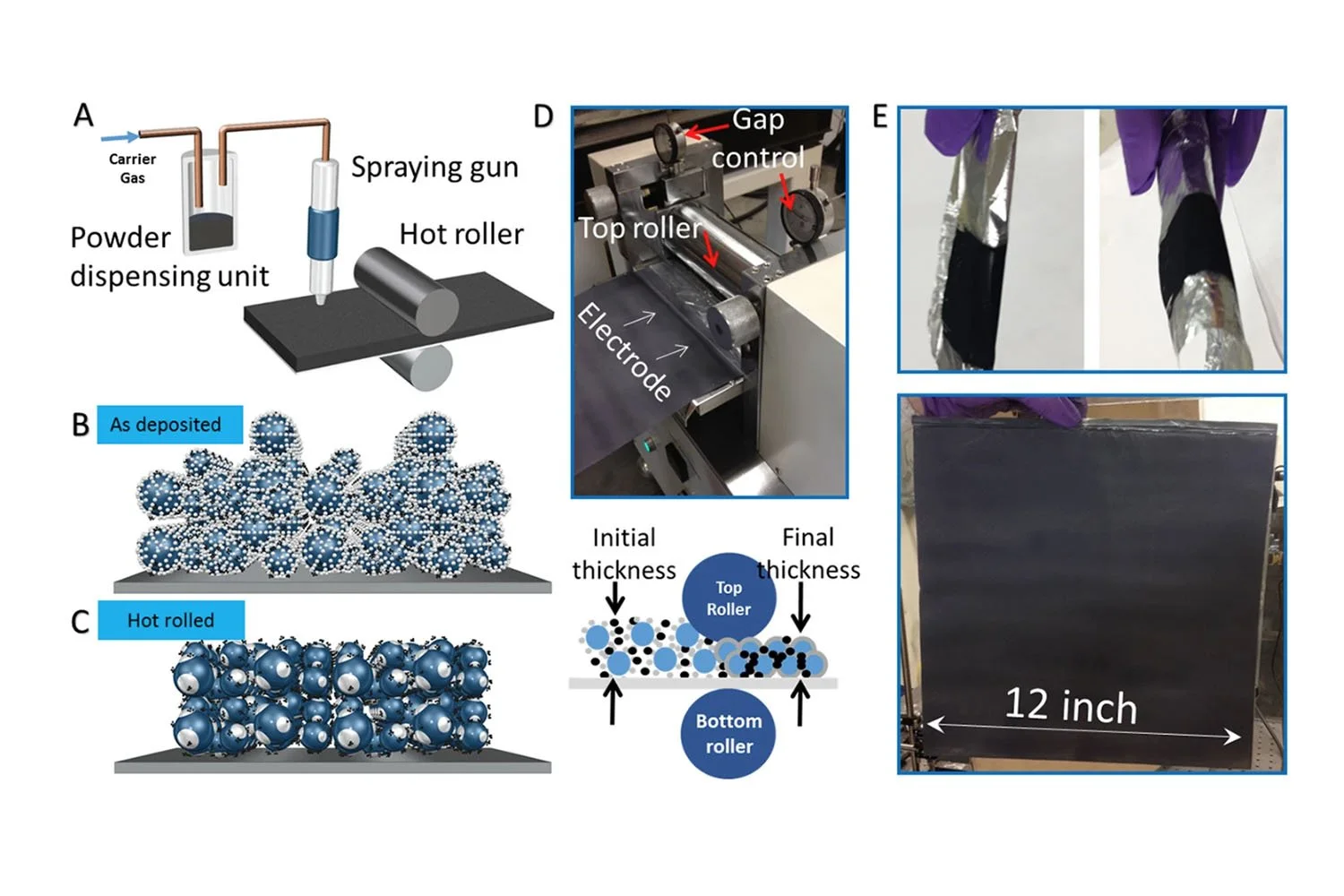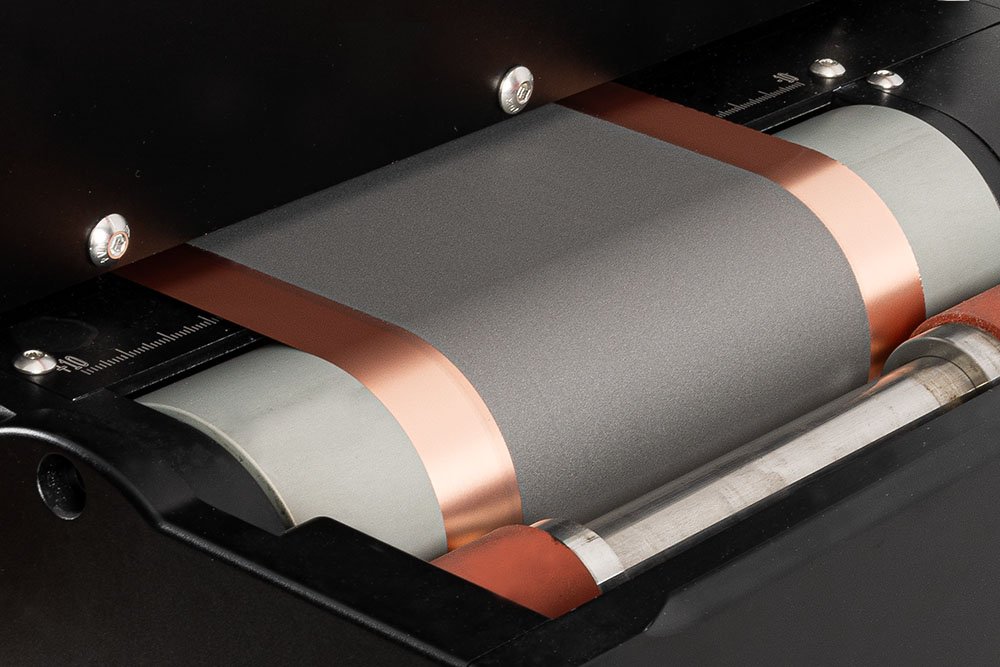What is Dry Battery Electrode Technology and How Does It Work?
A comparison of the typical electrode manufacturing processes: slurry-based (top) versus dry-based (bottom). Image Credit: Chemistry Europe
Dry Battery Electrode (DBE) technology refers to an innovative method for manufacturing electrodes for batteries, particularly lithium-ion batteries, without the use of liquid solvents. The primary difference between solvent-based battery electrode processing and DBE technology lies in the methodologies used to prepare the electrodes. Solvent-based processing involves creating a slurry of active materials mixed with solvents and binders, which is then slot-die coated onto a substrate and dried to remove the solvent, a process that can be time-consuming and environmentally challenging due to VOC emissions. In contrast, DBE technology eliminates the use of liquid solvents altogether, allowing for the direct application of dry active materials onto the conductive substrate, resulting in a more efficient, simplified manufacturing process. This dry approach not only reduces environmental impact and manufacturing costs but can also enhances the energy density and overall performance of the resulting batteries, making it an appealing alternative.
-
Solvent-based processing of battery electrodes, using slot-die coating or special designed slurry coaters, involves several key steps. First, a slurry containing active materials, conductive additives, and a solvent is prepared, ensuring proper mixing for homogeneity. Next, the slurry is pumped through the slot-die coater, where it is evenly deposited onto a substrate, typically a metallic foil. The gap in the slot-die controls the thickness of the coating. Following application, the coated electrode is dried to remove the solvent, facilitating adhesion of the material to the substrate. Finally, the dried electrode can be cut to size and further processed, such as calendaring, to enhance density and electrode performance. This method ensures uniform coating and high efficiency in electrode fabrication.
How to Perform Dry Battery Electrode Deposition
Electrostatic Spraying Deposition Method
Electrostatic spraying deposition is an innovative technique used to apply completely dry electrode particles onto a current collector in battery manufacturing. This method begins with the generation of a mist of dry electrode material particles, which are charged electrostatically. The charged particles are then directed towards the grounded current collector, where they are attracted and adhere to the surface. This electrostatic attraction ensures a uniform distribution of the electrode material, enhancing the quality and consistency of the coating. The process allows for precise control over the thickness and density of the electrode layer, which is crucial for optimizing battery performance. Additionally, since the particles are applied in a dry form, there is no need for solvents, making the process more environmentally friendly and reducing the risk of solvent-related issues. After deposition, the coated current collector may undergo further treatments, such as sintering or pressing, to improve adhesion and electrochemical properties.
A) Manufacturing system for electrodes created by dry particle painting process. (B) 3D representation of a dry painted electrode before thermal activation. (C) 3D representation of a dry painted electrode after hot rolling and thermal activation. (D) Hot roller configuration. (E) Dry painted electrodes on Al foils.
Image Credit: Nature.com
Dry Pressing Deposition
Dry pressing deposition is another technique used to apply dry electrode particles directly onto a current collector for battery fabrication. In this method, a mixture of dry electrode materials, which typically includes active materials, conductive additives, and sometimes a small amount of binder, is first blended to ensure uniformity. The dry powder is then placed onto the surface of the current collector, which is often made of metal, such as aluminum or copper.
Using a pressing machine, pressure is applied to the powder mixture, compacting the particles into a cohesive layer that adheres to the current collector. This mechanical compression not only aids in achieving a uniform thickness but also enhances the density and integrity of the electrode layer, improving its electrochemical performance. The pressing parameters, such as pressure and duration, can be optimized to control the final density and porosity of the deposited material, which are critical for ion transport and overall battery efficiency.
Roll to Roll Dry Battery Electrode Manufacturing
Roll-to-Roll (R2R) dry battery electrode manufacturing is a key advancement in the production of Dry Battery Electrode technology, emphasizing efficiency and sustainability. This continuous process involves feeding flexible substrates through a series of rollers where dry electrode materials are uniformly applied and compacted without the use of solvents. By eliminating liquid handling, the R2R method not only accelerates production but also minimizes the environmental impact associated with volatilizing organic compounds. The precise application of dry materials ensures consistent electrode quality and enhances performance by optimizing energy density. Furthermore, the scalability of the R2R process positions it favorably to meet the growing demands of the battery market while supporting innovations in energy storage systems. By integrating with techniques such as electrostatic spraying and dry pressing, R2R manufacturing offers a robust framework for the development of high-performance, eco-friendly battery electrodes.
A compact roll-to-roll coating machine used to create thin-film batteries.
Future Trends in Electrode Manufacturing
The future of electrode manufacturing is likely to be shaped by continued advances in DBE technology. Innovations may focus on developing new materials that enhance battery performance, including the incorporation of nanomaterials or advanced electrolytes that can work synergistically with dry electrodes. Moreover, the rise of automation and smart manufacturing will play a critical role in optimizing the production process, increasing scale, and ensuring quality control.
Conclusion
In conclusion, Dry Battery Electrode technology is set to redefine the landscape of battery manufacturing through its efficient, eco-friendly, and performance-boosting methods. As both the market demand and environmental considerations grow, DBE is likely to become an integral part of the future of energy storage solutions. Continued research and development in this area will further solidify its position in advancing battery technology.
Related Articles
What are Supercapacitors?
Supercapacitors, also known as ultra-capacitors or electric double-layer capacitors (EDLCs), are energy storage devices that have a higher capacitance than traditional capacitors.
Related Products
Laboratory Roll-to-Roll Coater
A compact and modular high precision roll-to-roll slot-die coater that transforms the way thin functional films are printed and coated.
Slot-die Heads
Slot-die heads for high-quality coatings. Available in stainless steel, titanium, or PEEK, with widths from 40 mm to 305 mm, ensuring precise thin-film production.








